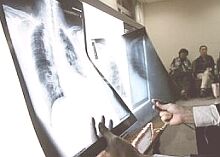 |
A chest x-ray or a sputum test can be used to help
diagnose TB. |
What causes TB?
A type of tubercle bacillus called Mycobacterium Tuberculosis is the cause of TB. Once the TB bacillus enters the body, it lodges in
the macrophages of the lungs. This begins a battle between the defence
cells in the body and the TB bacteria.
If the bacteria wins the battle, it starts to multiply in
the lungs, then spreads to other parts of the body. This is called primary
TB infection.
Most of the time, the human body is able to hold off the
TB germ by walling it and containing it within the lungs. However, these
TB germs may lie dormant for years and reactivate when a person's immune
system is weakened. This is known as post-primary infection, the most
common form of TB.
How does TB spread?
TB germs are spread through the air when an infected (and
untreated) person coughs or sneezes, spraying the air with tiny droplets
carrying thousands of these germs. An unsuspecting person who breathes
in these tiny droplets is at risk of contracting the disease.
The good news is that people with TB are non-infectious
as soon as they start treatment.
What are the symptoms of TB?
The most common symptom is chronic cough, lasting two weeks
or more. Often, the patient will also cough up blood-stained sputum, or
phlegm. This may be accompanied by loss of weight and appetite, fever
and night sweats, tiredness, weakness, as well as chest pain on coughing
or deep breathing.
How is TB diagnosed?
There are two common methods used to diagnose TB: a chest
x-ray and a sputum test. X-rays can detect TB to a certain extent, but
it cannot guarantee whether the patient has TB or some other infection.
Government hospitals use the sputum test to diagnose TB.
The patient is asked to cough up some phlegm and doctors observe it under
the microscope. If the patient's lungs are infected, the phlegm will contain
TB germs.
Can TB be treated?
In the early part of the 20th century, there was no treatment
for TB. People used to be isolated in places called a “sanatorium”, and
provided with bed rest and good food. There are now a number of drugs
to treat TB effectively. Today, TB treatment consists of various types
of medications to be taken over six months.
What are the side effects of TB treatment?
Side effects of TB treatment may include orange urine, saliva
or tears, itchiness or skin rash, blurred vision, dizziness and yellowish
eyes. Patients should discuss these side effects with their doctor or
nurse, and not stop treatment without medical advice.
Does TB cause death?
A 19th century American doctor William Sweetser recorded
symptoms observed in the late stages of TB infection, which included “frightful
emaciation, hollow cheeks, sunken eyes, throat ulcers and a graveyard
cough”. It is said that severe stomach cramps, excessive sweating, a choking
sensation and vomiting of blood would precede the victim's demise. These
painful symptoms and their fatal end can be prevented today by administering
the right treatment.
Is there a vaccination for TB?
BCG vaccination, given to all Malaysian children at birth,
protects against TB. However, it has been shown in a number of studies
that BCG only protects against childhood forms of TB, such as TB meningitis
and disseminated TB. Due to effective mass BCG vaccination in the country,
these two forms of childhood TB are now very rare. However, BCG does not
have much protection for adult forms of TB (most commonly TB of the lung).
References:
1. BBC Science, Hot Topics: Tuberculosis - http://www.bbc.co.uk/science/hottopics/tuberculosis/index.shtml
2. University of Medicine and Dentistry, New Jersey,
Brief History of Tuberculosis - http://www.umdnj.edu/~ntbcweb/history.htm
3. National Institute of Allergy and Infectious Diseases,
Focus On TB: Ancient Enemy, Present Threat - http://www.niaid.nih.gov/newsroom/focuson/tb02/tb.htm
4. KG Lim (1993), A Review of Diseases in Malaysia, Pelanduk
Publications, Selangor.

|

